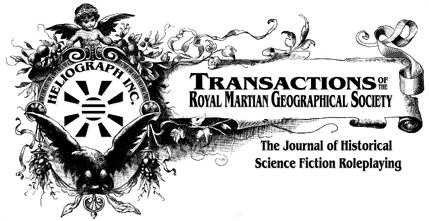
Buy | Submit | TRMGS1 | TRMGS2 | TRMGS3 | TRMGS4 |TRMGS Main | Heliograph Main
|
WHAT'S NEW?
The Complete Canal Priests Of Mars is now available!
The original publication of Canal Priests Of Mars cut slightly over a third of author Marcus L. Rowland's manuscript to fit GDW's adventure format.
The Complete Canal Priests Of Mars restores the cut material, features all new artwork by Paul Daly, and adds many useful player handouts. Enjoy the "author's cut" of a classic Space 1889 adventure, or experience it for the first time!
See our Buy It! page for more information!
Old news is still available on the News Page.
|
Australian Armed Forces In Space: 1889
by Peter Schutze
The lists of forces provided by various Space:
1889 products (such as Soldier's
Companion) contain some glaring inaccuracies with regard
to the lesser Armed Forces, particularly those of Australia. This article
supplements the information in Soldier's
Companion, and provides a more accurate list for Australian naval assets in 1889.
Colonial Navies
Each Australian colony maintains an independent naval force,
which in 1889 consisted of the following vessels.
Colony Name Type
Queensland Mosquito Yarrow-130 Torpedo Boat
New South Wales Wolverine Tornado Corvette (Spanish)
Acheron Lightning Torpedo Boat
Avernus "
Victoria Cerebus Coastal Defense Monitor
Childers Thornycroft 125 Torpedo Boat
Nepean Thornycroft 113 Torpedo Boat
Lonsdale "
Tasmania TB1 "
The classes used are the closest known equivalent provided in
the Ironclads and Ether Flyers product and appear in the British or
Australian section unless noted.
The Imperial Australian Squadron
In addition to the minor vessels controlled by the separate
colonies, there was a fairly large permanent contingent of the Royal Navy based
at Garden Island in Sydney Harbor.
1 Nelson-class armored cruiser
(Nelson)
3 Emerald-class corvettes
(Opal, Diamond, and one other)
In addition, three Osprey-class sloops were paid for and expected
to join the squadron during 1889-91.
The Australasian Auxiliary Squadron
Finally, for those whose campaigns extend beyond the year
1889, the Australasian Auxiliary Squadron was established in July 1891 by
the "Australasian Naval Defense Act." Passed by the British parliament on
20 December 1887, the act established a force that was jointly funded
by the Australian colonies and New Zealand but crewed by the Royal
Navy. This force came under the direct control of the Imperial Australian
Squadron, but could not be ordered out of Australasian territorial waters.
5 Pearl-class fast cruisers (same statistics as the
Mersey protected cruiser) of which 3 were active at any time including the Katoomba.
2 Rattlesnake-class torpedo Gunboats
(Boomerang and Karrakatta).
Army Units
Australia could have made an effective field force available to
support the Empire if it had been called on to do so. Contrary to the
data given in Soldier's Companion, there were fairly effective field
forces available of which the 'Light Horse' type units were only a part. For
example, in 1885 New South Wales dispatched a 500-man volunteer
Battalion of infantry supported by 2 batteries of 5 x 16lb Artillery to fight
in the Sudan at very short notice. Due to conditions in Sudan the
artillery batteries were re-equipped by the British command with 3 x 9lb
field guns each. These forces were organized and embarked on very
short notice once news of the strife was received.
The standard formation to be deployed in emergencies was the
brigade, which was organized as follows:
2 infantry regiments, each consisting of 2 battalions of 4
companies each.
1 mounted rifles regiment consisting of 6 companies
2 batteries of field artillery consisting of 6 guns each
1 company of engineers
110 medical and supply personnel
All companies conform to the standard Soldier's
Companion organization.
In peace time, most colonies had one battalion of full-time
infantry available, admittedly based at the fortifications, and at least
enough active (and paid) reservists to provide for their mounted rifles
commitment as well as the 'Staff' required to fulfill their contribution to
the planned brigades.
Fortunately, Australia never faced a threat so a full brigade was
never called up, although 8 were planned for and preparations made. The
men and equipment were available to fill out these brigades, with most of
the men coming from the retired British Army veterans that were
settled throughout the colonies.
The Australian colonies at various times also had various short
lived units that could best be described as 'experimental' such as
the Queensland Black Rifles.
In nearly every emergency involving the British Empire from the
early 1800s to the Falklands War (not inclusive) Australian troops have
been sent, either as small parcels or (from the Sudan on) as complete
units, most notable in the Sudan Campaign and the Boer War. It is very
likely that a battalion or more of Mounted Rifles and or infantry would be
sent, with artillery support. This is very true of situations such as the
Oenotrian War.
By the way, as late as 1891 the Australasian armed forces still
used the Martini-Henry rifle.
Last Updated Thursday, 19-Aug-2010 20:20:20 EDT
Return to Main Page
Comments to webmaster@heliograph.com
The material on this page is Copyright 2000 under the author or artist's name unless noted otherwise, and cannot be used without permission. This presentation Copyright 2000 by Heliograph, Inc. Space:1889 is a registered trademark of Frank Chadwick, all rights reserved, and is used with his permission. Most other game, movie, or book names may be trademarks of their respective holders, and use of a trademark at this site should not be construed as implying the sponsorship of the trademark holder, nor, conversely, should use of the name of any product without mention of trademark status be construed as a challenge to such status. Heck no! We love those guys.
